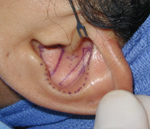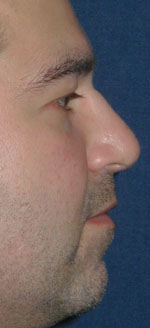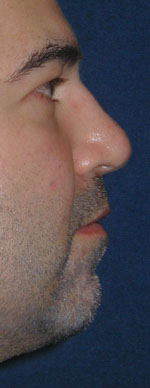Rhinoplasty offers improved
function
by
Heather WoolwinePublic Relations
Facial plastic surgery exists for increasing beauty as much as it does to improve function. Rhinoplasty is one such example.
 Dr. Adam Ross
Dr. Adam RossAdam Ross, M.D., MUSC Facial Plastic and Reconstructive Surgery director, described both reasons for rhinoplasty as valid. Although different perspectives, the two are intertwined. “The same techniques are often used for both kinds of rhinoplasties, and it makes sense that you wouldn’t want to alter function of the nose when you’re trying to alter someone’s cosmetic appearance,” he said. “Some patients have purely one issue to deal with while others may have a little of both. My job is to figure out what the complaint really is and go from there.”
Since the plastic surgery explosion in the 1980s, techniques attributed to altering someone’s nose were improved upon and revisited.
“There are several ways to approach a rhinoplasty, and as opposed to a brand new technique that is completely different, there are things that have ebbed and flowed throughout the decades,” Ross said.
 A picture of the
ear, and the shape of many grafts Dr. Ross routinely uses for nasal
reconstruction or rhinoplasty.
A picture of the
ear, and the shape of many grafts Dr. Ross routinely uses for nasal
reconstruction or rhinoplasty.When rhinoplasties gained popularity almost three decades ago, cartilage excision, or the removal of cartilage in the nose to refine and shape it into a different shape, placed first among noted techniques. Today, plastic surgeons know that this technique, if not done with utmost caution, causes the nose to contract and change over time. This makes for unhappy patients down the line who end up with a collapsed nose that doesn’t look or function well, and causes breathing problems.
Surgeons today, like Ross, rely on more advanced methods of rhinoplasty to achieve the results desired by patients. Deciding which method to use must be founded on a per case basis.
One technique calls for incisions on the outside of the nose, while another calls for incisions on the inside of the nose. Outside incisions, once thought taboo for scarring reasons, are fairly common right now, but Ross sees the pendulum swinging. “While I think that every facial plastic surgeon should be trained to perform both types of incisions, I think in the future we’ll see more internal incisions as surgeons recognize the many advantages of each approach and make an effort to return to procedures that avoid an external incision,” he said.
Another technique that Ross practices involves removing cartilage from another part of the body, like the ear. The key to this procedure is the skill involved to take cartilage from one area, place it in another, and leave no sign in either place that a scalpel was ever there.
“After performing hundreds of those procedures, you learn to camouflage cartilage grafts pretty well by using very precise instruments and soft tissue techniques,” Ross said. “It’s a very successful method.”
Some of the most common reasons, other than purely cosmetic purposes, that bring patients to Ross are nasal fractures or problems with nasal structures. He sees patients ranging in severity from issues like cleft nasal deformities or noses broken from trauma to those ravaged by disease, such as cancer. Most who come to see him with breathing problems usually suffer from either a twisted nose, where a fracture more than likely damaged the nasal passages, or a nasal valve collapse where the walls inside the nose fall when the patient tries to breathe.
More complicated than the simple perception of re-breaking someone’s nose, Ross and surgeons like him must employ their knowledge of all the various rhinoplasty techniques available in order to successfully treat a patient.

 One of Dr. Ross'
patients who had nasal obstruction from collapse also disliked the
dorsal hump on his nose, left photo. He underwent surgery, right photo,
with the placement of ear cartilage that improved his nose
cosmetically, in addition to a significant improvement in function.
According to Dr. Ross, appropriate placement of the cartilage graft is
not a cosmetic problem because he achieves balance between any
functional correction without any effects on cosmesis.
One of Dr. Ross'
patients who had nasal obstruction from collapse also disliked the
dorsal hump on his nose, left photo. He underwent surgery, right photo,
with the placement of ear cartilage that improved his nose
cosmetically, in addition to a significant improvement in function.
According to Dr. Ross, appropriate placement of the cartilage graft is
not a cosmetic problem because he achieves balance between any
functional correction without any effects on cosmesis.And contrary to a lot of pop culture myths about modern day rhinoplasties, patients are not subjected to six feet of nasal packing, nor does it take months to recover from a surgery.
“I don’t have to use nasal packing because I employ a quilting suture that serves to reattach the leaflets of skin in the nose and thus avoids the need for extra pressure,” Ross said. “If you are meticulous in your surgical technique, then most, if not all, bleeding can be avoided. Pain control is easily handled through a long-lasting local anesthetic, and icing the eyes and elevating the head after surgery help tremendously to reduce bruising. Some bruising is unavoidable, but usually after about 10 days you are hard pressed to find any signs that someone has had work done.”
With experience in dealing with a variety of nasal issues like broken bones, cosmetic issues, saddle noses (lack of cartilage), and repercussions of disease, Ross conducts thorough patient evaluation and consultations prior to surgery.
“Rhinoplasties are not just about the nose,” he said. “To execute an excellent surgery, you must consider proper balance, function, and an appreciation for aesthetics, as well as the obvious emotional issues involving facial surgery. I’ve watched and learned from well-trained facial plastic surgeons so I know where potential trouble spots or issues might surface. It’s easier to avoid them before they even happen. By learning from the best facial plastic surgeons, I feel like we’re 10 years ahead in the practice here at MUSC because of the quality of technique and care we can offer our patients.”
For more information, call 792-1414.
Friday, Oct. 7, 2005
Catalyst Online is published weekly,
updated
as needed and improved from time to time by the MUSC Office of Public
Relations
for the faculty, employees and students of the Medical University of
South
Carolina. Catalyst Online editor, Kim Draughn, can be reached at
792-4107
or by email, catalyst@musc.edu. Editorial copy can be submitted to
Catalyst
Online and to The Catalyst in print by fax, 792-6723, or by email to
petersnd@musc.edu
or catalyst@musc.edu. To place an ad in The Catalyst hardcopy, call
Community
Press at 849-1778.